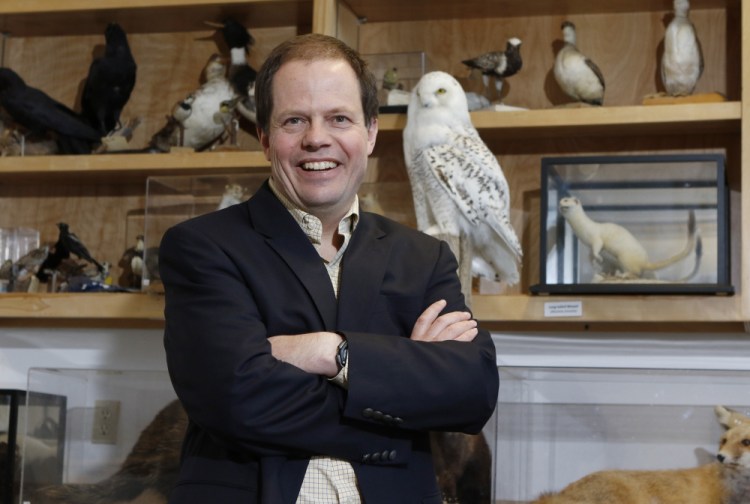Ole Amundsen, the new executive director of Maine Audubon, arrives with an impressive resume. He was the strategic conservation planning program manager for The Conservation Fund, a national land trust where he worked for eight years. He has a master’s degree in city and regional planning from the Massachusetts Institute of Technology, and he has worked for the Environmental Protection Agency and as a contractor for the Department of Energy assisting in the cleanup of a truly toxic place: Hanford Site in Washington state, where plutonium was manufactured for nuclear bombs. We called him up in his first month on the job, to talk birds and about his route to Maine, and found out it is a homecoming.
LANGUAGE LESSON: First of all, how is your first name pronounced? “It’s Eww-la,” Amundsen said cheerfully, in the tone of a man who has said this many, many times in his life. “It’s Norwegian.” His family had a summer camp on Hupper Island off Port Clyde, but he was born in Connecticut, spent the first eight years of his life on a farm in central Vermont, the next eight in Hanover, New Hampshire, and then moved to Maine full time in time to go to high school in Cape Elizabeth. “We were drawn by the good memories of the summers we had all spent in Maine.” He stuck around for college, going to Colby. As shorthand when people ask, he generally just says he’s from northern New England. “It is just easier.” He doesn’t call himself a Mainer. “I don’t claim to have been born in Maine. I know for some people that is important. But it is a good and deep connection.”
HOME SWEET HOME: Amundsen and his family settled in Waterville last August – his wife took a job in administration at Colby as the assistant vice president for facilities – and since then he has been looking at his old state with fresh eyes. “A lot of things have changed in Maine, and a lot of things have stayed the same. For the last six months, I have been doing a kind of compare and contrast.” What has he noticed? How populations are dwindling in northern and inland Maine, particularly in former mill towns. “It is pretty striking to see.” Although Maine Audubon is headquartered in Falmouth, Waterville is a good base for him. “It gives me a little bit of a different, statewide perspective,” he said, noting that some of Audubon’s most important resources lie inland, like the Fields Pond sanctuary near Bangor and Borestone Mountain sanctuary near Monson. So do some of its crucial monitoring programs, like the Maine Loon Project and the Brook Trout Pond Survey Project. “The northern Maine economy is something to be mindful of, and hopefully I can bring that awareness to the discussion.”
TELECOMMUTING: He’s down in Falmouth for part of the week and telecommutes the rest of the time. “This is 2016. We all work from home.” During his years with The Conservation Fund, he did a lot of telecommuting as well, living in Ithaca, New York, while the land trust was headquartered in Virginia. His work took him all over the country, including to Louisiana, where he helped develop a master plan for the state’s Department of Wildlife and Fisheries. The portfolio he managed included $50 million to help finance projects with short-term loans – one of which helped open the Boston Public Market, a central location for locally sourced foods. Audubon has been going through a strategic planning process, and he’s eager to help the group as it moves forward, particularly with engaging youth and working on issues of climate change. But mainstays, like connecting Mainers with wildlife and protecting rare and endangered species, won’t change.
LONGFELLOW LETTERS: Being the new boss has meant coming face to face with Maine Audubon history. “I’ve been looking in our safety deposit box, and there are original letters from (Henry Wadsworth) Longfellow in there.” What was Maine’s most famous poet writing to the group about? He had been, since boyhood, a member of the Portland Natural History Society, which was formed in 1843 and eventually merged with the first Maine Audubon Society just after the turn of the 19th century.
FARM TO DESK: Did his youth farming experience have a subtle influence on his career choice? The farm was on an inholding (private land within public property) within the Calvin Coolidge State Forest. Amundsen said he mostly remembers going to the barn in the morning to take care of the pony and the chickens, but it did have an impact. “The conservation community really tries to help working families stay on the land, so having seen firsthand how difficult a life that was was instructive.” His life as an athlete provided another personal connection. “In high school and at college, I was a runner, so I ran cross-country and track and skied for the Colby team,” he said. The setting was just as important as the sport. “That active lifestyle, being outside, going out to all these beautiful places, that was part of what I felt was invigorating.” And that has never changed.
Copy the Story Link
Send questions/comments to the editors.




Success. Please wait for the page to reload. If the page does not reload within 5 seconds, please refresh the page.
Enter your email and password to access comments.
Hi, to comment on stories you must . This profile is in addition to your subscription and website login.
Already have a commenting profile? .
Invalid username/password.
Please check your email to confirm and complete your registration.
Only subscribers are eligible to post comments. Please subscribe or login first for digital access. Here’s why.
Use the form below to reset your password. When you've submitted your account email, we will send an email with a reset code.